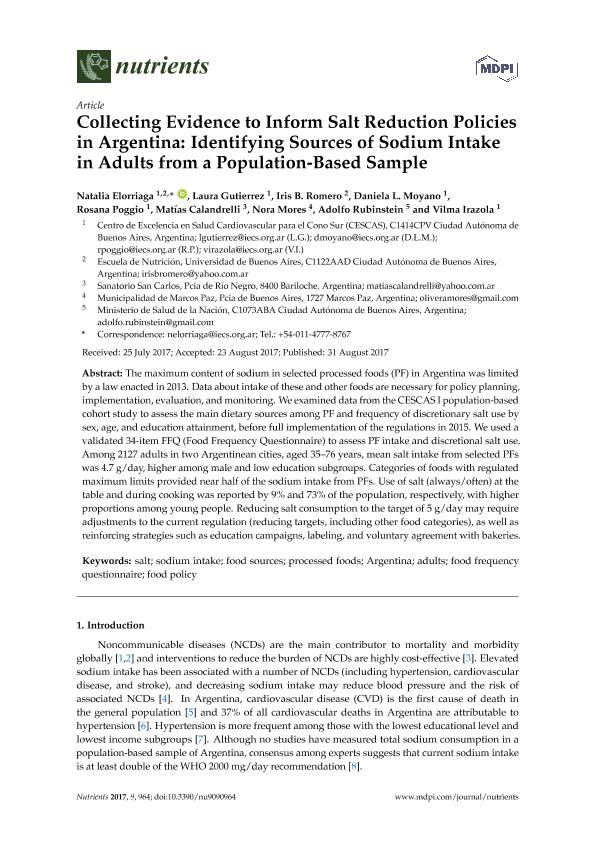Artículo
Collecting Evidence to Inform Salt Reduction Policies in Argentina: Identifying Sources of Sodium Intake in Adults from a Population-Based Sample
Elorriaga, Natalia ; Gutierrez, Laura; Romero, Iris Beatriz; Moyano, Daniela Luz; Poggio, Rosana
; Gutierrez, Laura; Romero, Iris Beatriz; Moyano, Daniela Luz; Poggio, Rosana ; Calandrelli, Matías Enrique; Mores, Nora Cecilia; Rubinstein, Adolfo Luis
; Calandrelli, Matías Enrique; Mores, Nora Cecilia; Rubinstein, Adolfo Luis ; Irazola, Vilma
; Irazola, Vilma
 ; Gutierrez, Laura; Romero, Iris Beatriz; Moyano, Daniela Luz; Poggio, Rosana
; Gutierrez, Laura; Romero, Iris Beatriz; Moyano, Daniela Luz; Poggio, Rosana ; Calandrelli, Matías Enrique; Mores, Nora Cecilia; Rubinstein, Adolfo Luis
; Calandrelli, Matías Enrique; Mores, Nora Cecilia; Rubinstein, Adolfo Luis ; Irazola, Vilma
; Irazola, Vilma
Fecha de publicación:
09/2017
Editorial:
MDPI AG
Revista:
Nutrients
ISSN:
2072-6643
Idioma:
Inglés
Tipo de recurso:
Artículo publicado
Clasificación temática:
Resumen
The maximum content of sodium in selected processed foods (PF) in Argentina was limited by a law enacted in 2013. Data about intake of these and other foods are necessary for policy planning, implementation, evaluation, and monitoring. We examined data from the CESCAS I population-based cohort study to assess the main dietary sources among PF and frequency of discretionary salt use by sex, age, and education attainment, before full implementation of the regulations in 2015. We used a validated 34-item FFQ (Food Frequency Questionnaire) to assess PF intake and discretional salt use. Among 2127 adults in two Argentinean cities, aged 35-76 years, mean salt intake from selected PFs was 4.7 g/day, higher among male and low education subgroups. Categories of foods with regulated maximum limits provided near half of the sodium intake from PFs. Use of salt (always/often) at the table and during cooking was reported by 9% and 73% of the population, respectively, with higher proportions among young people. Reducing salt consumption to the target of 5 g/day may require adjustments to the current regulation (reducing targets, including other food categories), as well as reinforcing strategies such as education campaigns, labeling, and voluntary agreement with bakeries.
Archivos asociados
Licencia
Identificadores
Colecciones
Articulos(CIESP)
Articulos de CENTRO DE INVESTIGACIONES EN EPIDEMIOLOGIA Y SALUD PUBLICA
Articulos de CENTRO DE INVESTIGACIONES EN EPIDEMIOLOGIA Y SALUD PUBLICA
Citación
Elorriaga, Natalia; Gutierrez, Laura; Romero, Iris Beatriz; Moyano, Daniela Luz; Poggio, Rosana; et al.; Collecting Evidence to Inform Salt Reduction Policies in Argentina: Identifying Sources of Sodium Intake in Adults from a Population-Based Sample; MDPI AG; Nutrients; 9; 9; 9-2017; 1-14
Compartir
Altmétricas



